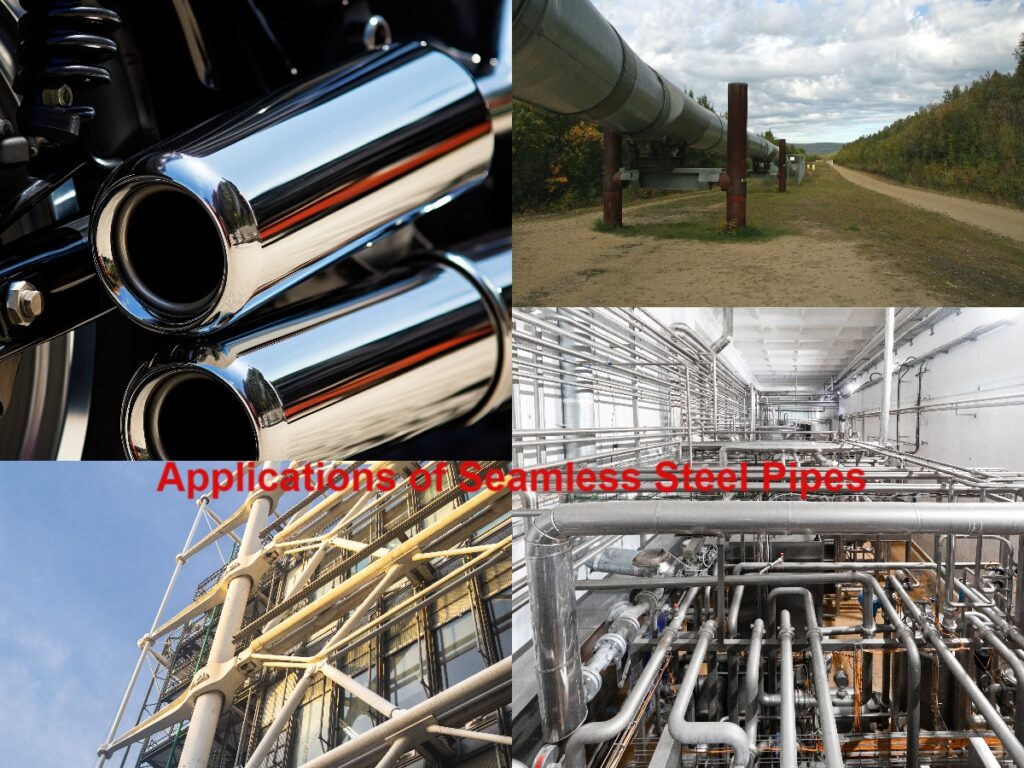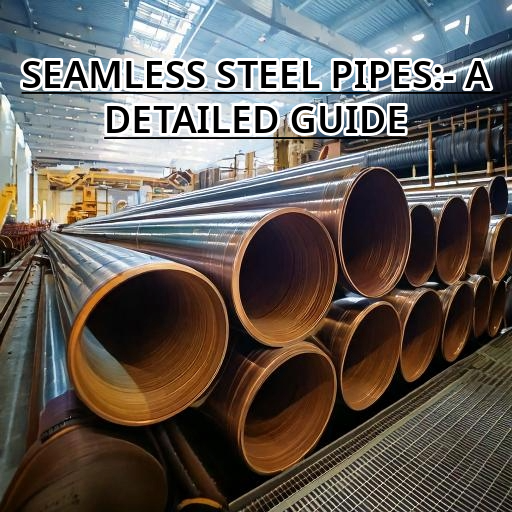Seamless steel pipes are one of the important subjects that have become very essential in the steel industry. The seamless steel pipes are made from a solid billet of steel which is formed in the shape of a cylindrical structure. In this process, there is no joint or welding of any kind due to which the structure of these pipes is absolutely uniform and strong.
Seamless steel pipes were developed during the Industrial Revolution for industry application when strong and reliable pipes were needed for high-pressure and high-temperature applications. Most of these pipes are used in oil and gas transportation, power generation, chemical processing, and boiler applications. The main advantage these pipes have is that they can easily withstand high pressures and have good corrosion resistance.
The manufacturing process first involves heating of the steel billet, followed by drilling the desired shape and size with the help of a mandrel. Such pipes are prepared in various specifications and dimensions, which could be customized according to user’s requirement. Today, seamless steel pipes are considered high-demand products for their strength, durability, and superior quality, and also as a reliable choice for industries.

What are Seamless Steel Pipes?
Seamless steel pipes are pipes without any joint or welding. They are made by heating a solid cylindrical billet and then converting it into a hollow structure. The production process of seamless pipes makes them more durable and stronger because they don’t have any weak points that can happen in welded pipes due to the joints.
They find application in various fields where high pressure, temperature, and strength are needed, like the oil and gas industry, power plants, boilers, chemical industries, and automobiles. Seamless pipes have resistance toward corrosion and a smooth surface; hence, they are good for transporting fluids and gases.
Seamless steel pipes are available in different sizes and grades, like carbon steel, alloy steel, and stainless steel. The quality of this material controls is very stern in order for it to meet all international standards.

Seamless pipes are a bit expensive to produce than welded pipes, but the extra strength and reliability grant them the status of being trusted for critical applications.
Manufacturing Process of Seamless Steel Pipes
Selection of Raw Material
The first stage in the manufacturing of seamless steel pipes is selecting high-quality steel billets. Normally, a billet has a cylindrical shape with a solid form, hence it possesses good quality with uniform composition of steel. It is checked for impurities in the chemical composition of the billets and their uniformity. The quality of the raw material being used will directly influence the durability and strength of the pipe.
Heating and Piercing
Here, the steel billets are heated in high-temperature furnaces to a temperature of approximately 1200-1300°C. This makes the billets soft and thus malleable. Then using a piercing machine, a hole is made in the centre of the billets. This hollow structure is the first step in making seamless pipe. The piercing process uses mandrels and rollers, which ensure uniform thickness and shape.
Elongation and Rolling
These pierced billets are then passed in elongation rolling mills where they are stretched to desired length and thickness. The rolling process produces uniform diameter and thickness. After rolling the structure of the pipe becomes strong and its inner surface is smooth. At this stage, the basic shape and size of the pipe is formed.
Heat Treatment
Heat Treatment: The pipes are placed in annealing furnaces where this heat treatment process is carried out. This heat treatment improves the mechanical properties of the steel, including ductility and toughness. It provides pipes with a homogenous micro-structure and also increases their stress-bearing capacity. The pipes are then cooled down by either slow cooling or by using controlled cooling processes.
Sizing and Finishing
The heat-treated pipes are then passed through sizing mills where pipes are machined to exact diameter and thickness. Finishing processes include polishing, removing burrs, and smoothing edges. The surface of the pipes is inspected and any defects are removed.
Quality Inspection
At the last stage, the pipes go through a rigorous quality inspection. The strength, durability, and uniformity of the pipes are checked by means of destructive and non-destructive tests. Hydrostatic tests, ultrasonic tests, and visual inspections ensure that the pipes are leakage-proof and defect-free.
Packing and Dispatch
After quality approval, the pipes are packed in a proper way. The packing process protects them from rust and damage. Then, the pipes are dispatched as per the customer’s specifications.
Properties of Seamless Steel Pipes
High Strength and Durability
Seamlessness steel pipes possess a very high strength since they are manufactured in a continuous process without welds or joints. That is why they resist difficult conditions, such as high pressure and temperature, with ease. On that basis, their use is achieved in oil and gas, power plants, and industrial applications. The performance of seamless pipes with regard to this aspect is unmatched by any material; they tend to work for long periods of time without deteriorating.
Corrosion Resistance
Another special property of seamless pipes is that they possess resistance to corrosion. They are made from different materials such as stainless steel, which are rust-proof. This feature makes them useful in chemical industries and marine environments where moisture and exposure to aggressive chemicals are high.
Smooth Surface Finish
This makes the surface finishing of seamless pipes much smoother than that of welded pipes, since there is no welding joint. The fluid and gas flow inside the pipes is, therefore, uninterrupted, hence improving efficiency. This has made seamless pipes preferable in hydraulic systems and precision engineering.
High Pressure and Temperature Tolerance
Seamless steel pipes have a structure that makes them ideal in extreme pressures and temperatures. In such pipes, the structure is uniform, hence their even distribution of pressure reduces chances of pipeline failures. This property is useful in boilers, refineries, and high-pressure gas transmission.
Customizability
Seamless steel pipes can be manufactured to many different specifications. The diameter, thickness, and length of the pipe can all be changed to suit customer requirements. This flexibility has made them widespread across a variety of applications, from aerospace to general engineering.
Applications of Seamless Steel Pipes
Oil and Gas Industry
The oil and gas industry accounts for the largest use of seamless steel pipes. They are used in transporting crude oil, natural gas, and refined petroleum products. Their strength and resistance to high pressures, therefore, make them suitable for deep-sea drilling and operation under extreme environmental conditions. They reduce the risk of leaks and failures because they are not a welded structure. This is important for safety and efficiency.
Power Plants
Seamless steel pipes can be used under high temperatures and pressures in both thermal and nuclear power plants. This allows efficient transfers of steam and fluids, very necessary for the proper functioning of turbines and boilers. Their heat and corrosion resistance gives them long-term reliability.
Automobile Industry
Seamless steel pipes play a very crucial role in the engines and exhaust systems of automobiles. Their high strength and light weight properties enhance fuel efficiency and assure durability of vehicles. High precision helps in smooth functioning and performance improvement.
Construction Sector
Seamless steel pipes in building and infrastructure projects give a structure and hold plumbing in their place. Characteristics of high tensile strength and resistance to rust make them most suitable for heavy-duty applications. They are also used in bridges and skyscrapers, where stability with high strength must be ensured.
Chemical Industry
Seamless steel pipes are used in chemical plants for the safe transportation of corrosive and toxic chemicals. Their non-reactive nature and high-pressure tolerance ensure the safety and efficiency of operation. Compatibility with the most aggressive chemicals at varying temperatures increases their usefulness and demand.

Advantages of Seamless Steel Pipes
Durability and Strength: The seamless steel pipes boast strength and durability, with their most outstanding feature being no welded joints; therefore, the mechanical properties in these pipes strengthen. They will easily function at high pressures and extreme temperatures and thus have massive use in industries that deal with oil and gas, power plants, and chemical plants. The uniformity in the structure of the pipe renders them corrosion and wear resistant and thus elongates their life.
Uniform Structure and Reliability: Seamless pipes have a homogenous structure, as a result of which they ensure reliability. They do not have weld seams, and hence the probabilities of cracks or leakage in them are immensely reduced. As a result, seamless pipes become one of the most trusted choices for critical applications where safety and performance are vital.
High Efficient Performance: The interior surface of the pipes is smooth, which assures high flow efficiency. They can easily carry high-pressure liquids or gases. They also have low maintenance costs because they don’t need to be repaired often.
Challenges of Seamless Steel Pipes
High Cost: The production of seamless pipes is quite a complex and expensive process. The raw material, added with the specialized machinery, makes them highly expensive. So, they are much more costly than welded pipes, which tends to be burdensome for small scale industries.
Restricted Size and Thickness: The manufacturing of seamless pipes has limitations in size and thickness. The large diameter and certain thickness requirements sometimes make their production difficult. This limitation makes them unsuitable for particular applications where customized sizes are a prerequisite.
Special Manufacturing Requirements:
Seamless pipes require high expertise and advanced technology for their manufacture. Not all countries have the facilities to have this process done, hence creating supply chain challenges. Import is necessary, increasing both delivery time and cost.
Maintenance Tips for Seamless Steel Pipes
To Increase Life Span and Reliability of Seamless Pipes:
Apply Protective Coating: Use corrosion-resistant cuttings such as galvanization.
Regular Inspection: Check for cracks or wear from time to time.
Proper Storage: Store in a dry and covered area.
Why Choose Seamless Steel Pipes?
Seamless steel pipes do well in projects asking for high performance and reliability. In critical applications where leakage and strength cannot be compromised, seamless pipes are the better choice.
Conclusion
Unmatched strength, durability, and leak-proof design of seamless pipes have made them the most indispensable part of modern industries. Be it oil & gas, construction, or automotive, these pipes perform everywhere. When uncompromised quality and long-term reliability are required, seamless steel pipes are a proven solution. Invest in strength. Choose seamless steel pipes!




Pingback: What is HOT ROLLING MILL? - STEEL PRODUCT INFO.
Pingback: STAINLESS STEEL PIPES & TUBES:- DETAILED INFORMATION